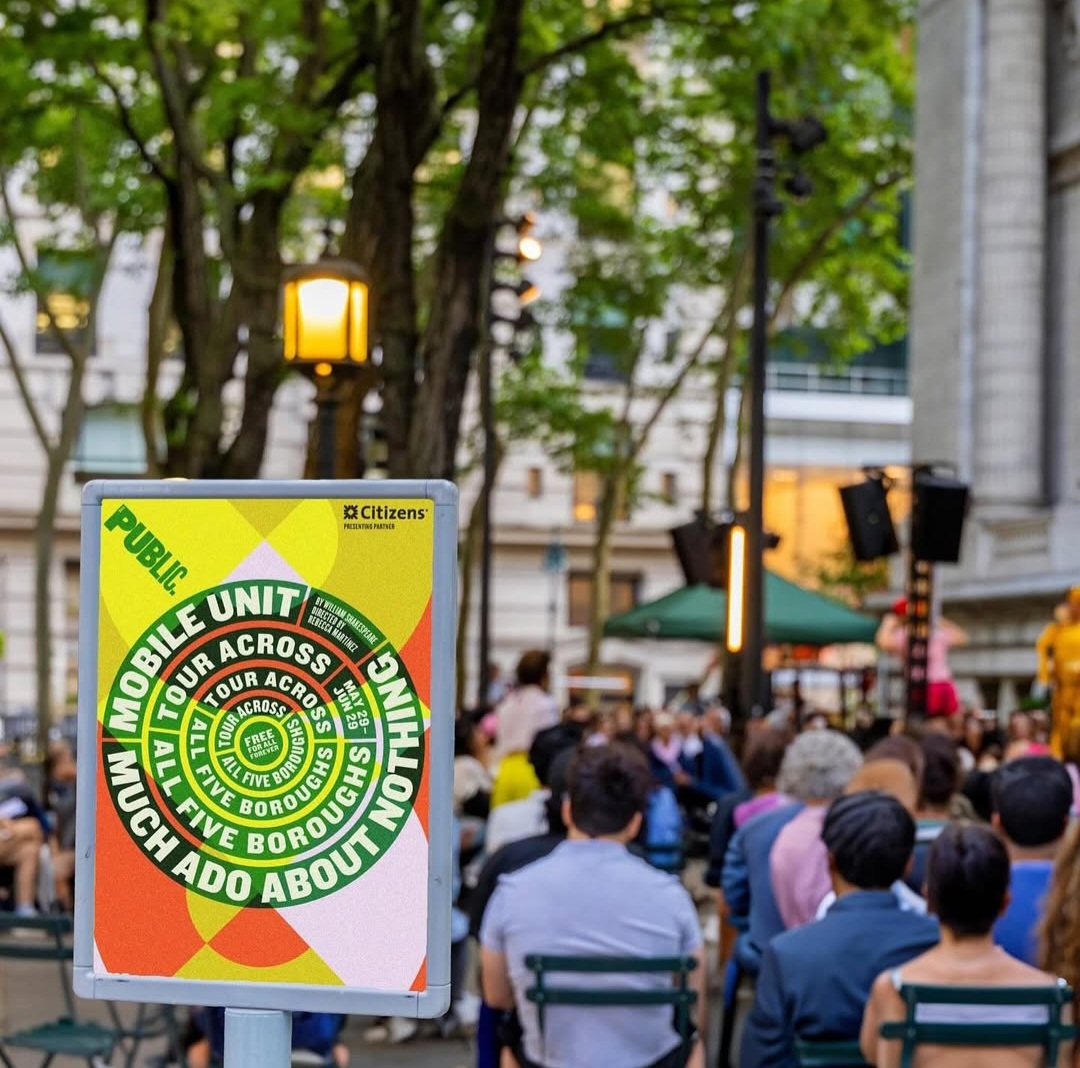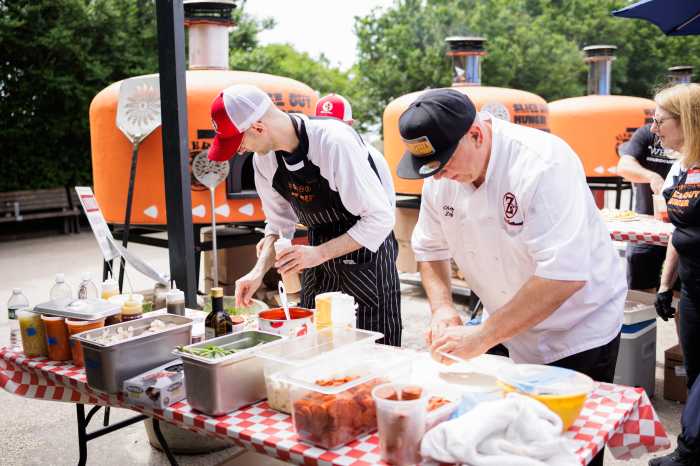By Julie Shapiro
People walking on Fulton St. see only the tall construction barriers and narrowed sidewalks, but behind those barriers is something else altogether — progress.
Every day, dozens of construction workers fill the trenches of tangled pipes beneath Fulton St., excavating and replacing utilities that are decades old. At the center of the work is the water main that started it all: a crumbling cast-iron pipe installed just after the Civil War.
The person charged with overseeing the massive utility and streetscape project is Thomas Foley, an assistant commissioner with the city Dept. of Design and Construction. A year and a half into the project, Foley gave Downtown Express a tour of the work last week, explaining the progress and all that still has to be done.
When the $32 million project is finally complete in the spring of 2012, no inch of Fulton St. will remain untouched. Two new water mains will run from Church St. down to South St.; many of the Con Edison, Verizon and Time Warner facilities will be new; and three new parks will dot the remade street.
The broad scope of the work means many parties are involved, and one of Foley’s toughest jobs is coordinating all of them. He also has to contend with the uncertainty of what exactly is below the surface of Fulton St., which has not been exposed from curb to curb in about 100 years.
“It’s only once the road has been excavated and the facilities exposed that we know the exact location and depth of the facilities,” Foley said. “Each block is different…. Nothing’s going to fit perfectly as per planned, as per designed, and it never will in Lower Manhattan.”
Despite the uncertainties, Foley said the project is on budget and on schedule.
The first phase of the project, on Fulton St. between Church and Gold Sts., will be done by the end of the year, which will be almost two and a half years after it began. The city has replaced 70 percent of the water main along that stretch, with utility and subway work following behind and streetscape improvements coming later this year.
The improvements and added green space will be welcome, but businesses and residents on Fulton St. are growing impatient for the seemingly never-ending project to be complete.
“Help!” said Kevin Long, owner of the Exchange bar and lounge, when a reporter asked about the construction outside his front door near Gold St. “That is definitely hurting business.”
Long took over the Exchange six months ago and said the worst part of the water main work is that the street feels scary at night, discouraging foot traffic from getting anywhere near his bar. Long is hopeful that the remade street will be a boon to business, but he added, “When, in 2054?”
“Downtown is nice,” Long said. “It just needs to be hurried up a little.”
Digging under Fulton near the corner of William St.
Part of the reason the project is taking so long is because the work goes far beyond just replacing the water main. To ensure that the street won’t be ripped up again anytime soon, the many agencies and companies with utilities below Fulton St. are fixing and replacing them. The dense packing of the utilities requires workers to excavate them carefully by hand, which takes more time than using machines. Another thing that slows the work is the need to maintain service to the businesses and residents on the street, Foley said.
“There’s naturally going to be concerns,” Foley said. “It’s a large project.”
In a trench one block east of Long’s bar is the clearest sign of progress: The old rust-colored 16-inch water main meets the new, dark gray 20-inch one. The city slated the Fulton St. main for replacement to avoid breaks like the one on Chambers St. last fall, which flooded an entire block, Foley said.
The space around the Fulton St. main looks packed with pipes and wires from other utilities, but the city will also have to find room for an additional 24-inch water main alongside the 20-inch one. The 24-inch main will be like a highway, serving much of the neighborhood, while the 20-inch main will serve just the homes and businesses on Fulton St.
One piece of the work the city won’t be able to finish is at the intersection of Fulton St. and Broadway, where the Fulton Transit Center was supposed to rise. The Metropolitan Transportation Authority ran out of money to complete the center and has not said what will go in its place or when. The city originally planned to rebuild the sidewalks and make other improvements near the transit center, but now the M.T.A. will take over that job whenever they build the center, Foley said.
Over the next few months, the city will begin construction east of Gold St., moving down toward South St. with work outside Southbridge Towers and St. Margaret’s House, large apartment buildings. The city will also begin constructing three parks: DeLury Square and Titanic Park along Fulton St. and Burling Slip one block away on John St. All three parks will open by early next year.
But right now, visions of green space and free-flowing traffic feel far off on a street that has been plagued by noise, rats and water shutoffs since the project started.
“It’s a disaster,” said Richard Butler, who moved to Fulton St. between Broadway and Nassau St. two years ago. “It’s an absolute disaster.”
Jackhammers and trucks have woken Butler and his wife Jenny before 7 a.m. and kept them up past 11 p.m. They frequently stumbled outside in their pajamas, begging the workers to quiet down.
In the past several months, the late-night and early-morning noise has abated, and Butler credited helpful liaisons from the city. But he said he is tired of constantly being told the work is almost over, only to find it dragging on.
“The project itself has taken a simply unconscionably long time,” Butler said. “It’s almost laughable.”
Foley said parts of the excavated street may look inactive for days or weeks at a time, but there is always a good reason. Some work cannot be done when it’s too hot or too cold. Poured concrete may need several days to set before any work can be done nearby. And it would be a waste of time and money to repave the street in between phases of work if it will have to be opened up again several weeks or months later.
One lesson that Foley learned from working with the community is that Lower Manhattan is not the same place it was a decade ago. When the Fulton St. work started in the summer of 2007, the contractors didn’t think twice about doing the noisiest pipe-cutting work at night — in fact, since the city considered the area a business district, the general policy was to schedule all loud or disruptive construction at night.
“Ten years ago, it wouldn’t have been an issue with residents in Lower Manhattan,” Foley said. But he quickly realized the city’s policy would have to change, and as of about a year ago, he limited the pipe cutting and the loudest work to the daytime whenever possible. All the jackhammers on the site are now fitted with mufflers, and the backup alarm on the trucks is not a high-pitched beeping, but rather a staticky pulse.
Foley also had to decide when to do water shutoffs. The residents want them during the day, when they’re away from their apartments, and the restaurants want them in the middle of the night, when they are closed. Foley ultimately decided on a combination of daytime and nighttime shutoffs.
“It’s always a juggle,” Foley said. “You try to make everyone happy. You’re never going to do that, but it’s a constant effort that we make.”
When the work moves closer to Southbridge Towers and St. Margaret’s House, both of which have a large senior population, the city will have to figure out how to accommodate residents are home during the day. One possibility is to do the loud work during the day and the water shutoffs at night, said Joseph Pally, spokesperson for the city Economic Development Corp.
So far, the businesses east of Gold St. have remained largely untouched by the construction that was happening to the west of them, but that’s about to change: In the next few months, the water main work will continue moving eastward.
“I’m not happy about it,” said Joseph Nisanov, manager of the Kosher Luncheonette at Cliff and Fulton Sts. “The economy is not too great already.”
Nisanov, like other business owners on Fulton St., said he felt there was little he could do to save his business.
“Who are we to argue with them?” he said. “They have to do it, they have to do it.”
The Lower Manhattan Development Corp. has a grant program, designed specifically with Fulton St. in mind, which is helping small businesses on streets closed by construction. Since the program launched last year, the L.M.D.C. has given $475,000 to about 50 businesses in Lower Manhattan. Fifteen of those businesses are on Fulton St., and they received a total of around $200,000. Grants are capped at $25,000 per business.
The L.M.D.C. is also granting business owners up to $275,000 to overhaul their storefronts and facades with new lights, awnings and windows.
Ch Lee, whose wife owns the T-shirt store Red & Blue Inc. at Fulton and Cliff Sts., was not sure he’d be able to keep the shop open once construction starts on his block, grant money or no grant money.
“It will kill just about every store,” he said, shaking his head.
The recession has dropped his business to the lowest sales he has seen in 20 years, lower even than the months just after 9/11, Lee said. He has two children in college and a third starting college next fall.
“I don’t want to closing,” Lee said. “But what you going to do?”
Julie@DowntownExpress.com


































